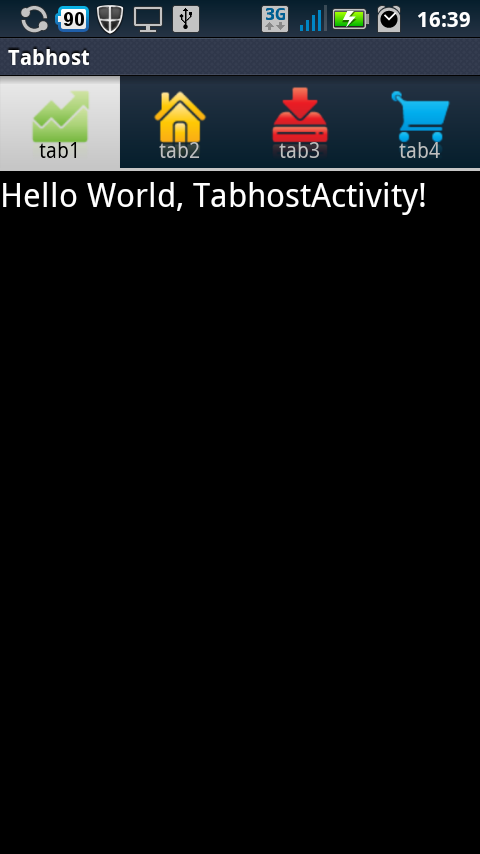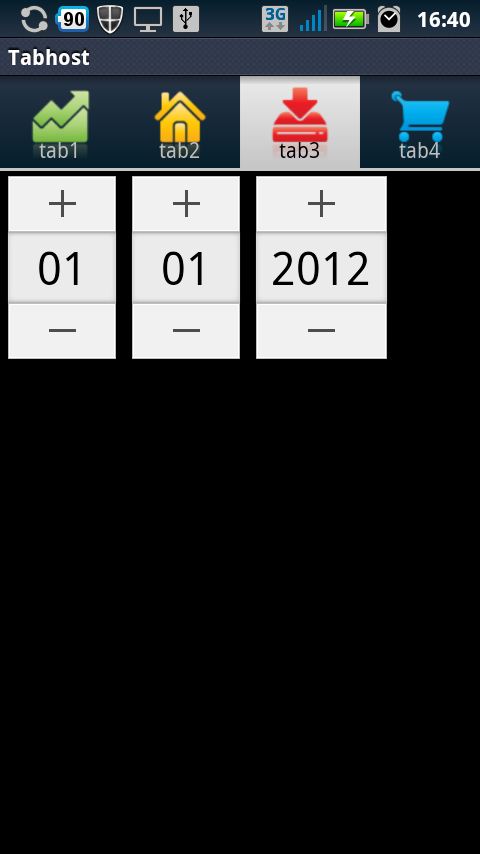Tabhost算是較為進階的UI,對於Android初學者來說有些地方不太好理解,因此來簡單的分享一下。
Tabhost算是較為進階的UI,對於Android初學者來說有些地方不太好理解,因此來簡單的分享一下。
一開始先建立一些string來提供wdget使用(非必要,主要是用於tabhost上的LinearLayout):
Hello World, TabhostActivity!
Tabhost
接著配置main.xml:
<?xml version="1.0" encoding="utf-8"?>
<FrameLayout xmlns:android="http://schemas.android.com/apk/res/android"
android:layout_width="fill_parent"
android:layout_height="fill_parent">
<LinearLayout
android:id="@+id/linearLayout1"
android:layout_width="match_parent"
android:layout_height="match_parent"
android:orientation="vertical" >
<TextView
android:id="@+id/textView1"
android:layout_width="wrap_content"
android:layout_height="wrap_content"
android:text="@string/hello"
android:textAppearance="?android:attr/textAppearanceLarge" />
</LinearLayout>
<LinearLayout
android:id="@+id/linearLayout2"
android:layout_width="match_parent"
android:layout_height="wrap_content"
android:orientation="vertical" >
<Button
android:id="@+id/button1"
android:layout_width="wrap_content"
android:layout_height="wrap_content"
android:text="@string/hello" />
</LinearLayout>
<LinearLayout
android:id="@+id/linearLayout3"
android:layout_width="match_parent"
android:layout_height="match_parent"
android:orientation="vertical" >
<DatePicker
android:id="@+id/datePicker1"
android:layout_width="wrap_content"
android:layout_height="wrap_content" />
</LinearLayout>
<LinearLayout
android:id="@+id/linearLayout4"
android:layout_width="match_parent"
android:layout_height="match_parent"
android:orientation="vertical" >
<EditText
android:id="@+id/editText1"
android:layout_width="match_parent"
android:layout_height="wrap_content" android:bufferType="editable">
<requestFocus />
</EditText>
</LinearLayout>
</FrameLayout>
以上這個部份因為不是重點所以只做一點簡單的說明。這部份是由一個FrameLayout和四個LinearLayout所組成來作為Tabhost的內容。
最後是Tabhost的重點 - 關於java code的部分:
package com.myhost;
import android.os.Bundle;
import android.view.LayoutInflater;
import android.widget.TabHost;
import android.app.TabActivity;
public class TabhostActivity extends TabActivity { // Extend TabActivity class
/** Called when the activity is first created. */
@Override
public void onCreate(Bundle savedInstanceState) {
super.onCreate(savedInstanceState);
TabHost tabHost = this.getTabHost(); // The activity TabHost
LayoutInflater.from(this).inflate(R.layout.main, tabHost.getTabContentView(), true);
tabHost.addTab(tabHost.newTabSpec("tab1")
.setIndicator("tab1", getResources()
.getDrawable(R.drawable.chartareaup_green))
.setContent(R.id.linearLayout1));
tabHost.addTab(tabHost.newTabSpec("tab2")
.setIndicator("tab2", getResources()
.getDrawable(R.drawable.home_yellow))
.setContent(R.id.linearLayout2));
tabHost.addTab(tabHost.newTabSpec("tab3")
.setIndicator("tab3", getResources()
.getDrawable(R.drawable.harddrivedownload_red))
.setContent(R.id.linearLayout3));
tabHost.addTab(tabHost.newTabSpec("tab4")
.setIndicator("tab4", getResources()
.getDrawable(R.drawable.shoppingcart_blue))
.setContent(R.id.linearLayout4));
}
}
一開始我們必須讓class繼承TabActivity,接著宣告Tabhost變數,並透過getTabHost來取得Activity的TabHos reference。
然後透過TabActivity取得LayoutInFlater。LayoutInFlater這個類別是用來實體化layout的xml檔。這邊使用的方式是先利用from(this)取得本context的LayoutInFlater,再透過inflate()實體化指定的xml來建立新的view hierarchy。 接著加入TabSpec到Tabhost中,TabSpect是一種建立indicator, content, tag的builder。
顯示的效果如下:
結論:
Tabhost的實作其實並不是太複雜,只是有許多地方比較難以被理解而已。另外在網路上有關於如何實作動態Tabhost的部分,這部分等我弄清楚些再跟大家分享。


